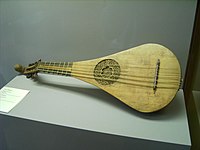Our website is made possible by displaying online advertisements to our visitors.
Please consider supporting us by disabling your ad blocker.
Gittern
 Five course Gittern or "Quintern" dated 1450, built by luthier Hans Oth | |
| Classification | String instrument (plucked) |
|---|---|
| Hornbostel–Sachs classification | 321.322 (necked box lute) (Chordophone) |
| Developed | 13th century |
| Related instruments | |
The gittern was a relatively small gut-strung, round-backed instrument that first appeared in literature and pictorial representation during the 13th century in Western Europe (Iberian Peninsula, Italy, France, England). It is usually depicted played with a quill plectrum,[1] as can be seen clearly beginning in manuscript illuminations from the thirteenth century. It was also called the guiterna in Spain, guiterne or guiterre in France, the chitarra in Italy and Quintern in Germany.[2] A popular instrument with court musicians, minstrels, and amateurs, the gittern is considered an ancestor of the modern guitar and other instruments like the mandore, bandurria and gallichon.[3][4]
From the early 16th century, a vihuela-shaped (flat-backed) guitarra began to appear in Spain, and later in France, existing alongside the gittern. Although the round-backed instrument appears to have lost ground to the new form which gradually developed into the guitar familiar today, the influence of the earlier style continued. Examples of lutes converted into guitars exist in several museums, while purpose-built instruments like the gallichon utilised the tuning and single string configuration of the modern guitar. A tradition of building round-backed guitars in Germany continued to the 20th century with names like Gittar-Laute and Wandervogellaute.
Up until 2002, there were only two known surviving medieval gitterns,[5][6] one in the Metropolitan Museum of Art (see external links), the other in the Wartburg Castle Museum. A third was discovered in a medieval outhouse in Elbląg, Poland.[6][7]
- ^ P. 118. The Encyclopedia of Music. New York: Hermes House, 2002.
- ^ The Grove Dictionary of Musical Instruments (2nd Edition) (April 2014). Quinterne [quintern]. ISBN 978-0-19-974339-1. Retrieved 2015-03-20.
{{cite book}}: CS1 maint: numeric names: authors list (link) - ^ Tyler, James (January 1981). "The Mandore in the 16th and 17th Centuries" (PDF). Early Music. 9 (1): 22–31. doi:10.1093/earlyj/9.1.22. Retrieved 10 April 2019.
...the small, lute-like instrument of the Middle Ages called, until recently, the 'mandora' by modern writers, was originally called the 'gittern'...generally used for the small, four-course, renaissance guitar, but it was still also occasionally used (until well into the 17th century) for the instrument which, during the 16th century, became known as the 'mandore'. ... it is to the Spaniard Juan Bermudo that we must turn... in his Declaration de instrumentos (1555), Bermudo speaks of the bandurria...
- ^ Meucci, Renato (2001). "Da 'chitarra italiana' a 'chitarrone': una nuova interpretazione". Enrico Radesca da Foggia e il suo tempo: Atti del Convegno di studi, Foggia, 7–8 Aprile 2000. pp. 30–57. ISBN 978-887096347-2.
- ^ Tyler, James; Sparks, Paul (1992). The Early Mandolin. Oxford: Clarendon Press. pp. 1–7. ISBN 0-19-816302-9.
- ^ a b Martin Kirnbauer; Musikwissenschaftl. Institut; Uni Basel. "Mittelalterliche Musikzeugnisse". Archived from the original on 2004-12-25. Retrieved 2010-12-06.
- ^ "Unprofitable Instruments". Retrieved 2010-12-06.
Previous Page Next Page


